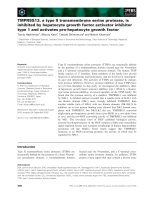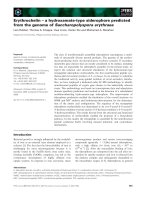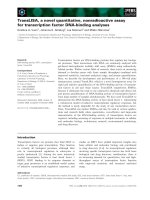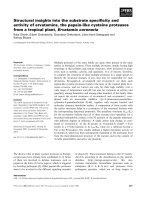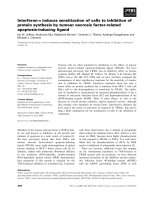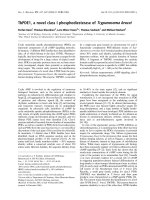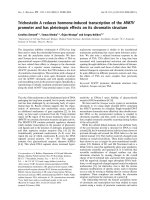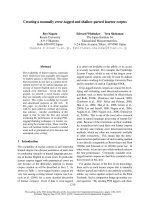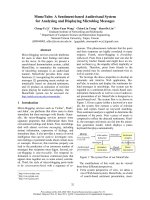Báo cáo khoa học: Gliadain, a gibberellin-inducible cysteine proteinase occurring in germinating seeds of wheat, Triticum pdf
Bạn đang xem bản rút gọn của tài liệu. Xem và tải ngay bản đầy đủ của tài liệu tại đây (1.69 MB, 10 trang )
Gliadain, a gibberellin-inducible cysteine proteinase
occurring in germinating seeds of wheat, Triticum
aestivum L., specifically digests gliadin and is regulated
by intrinsic cystatins
Toshihiro Kiyosaki
1
, Ichiro Matsumoto
1
, Tomiko Asakura
1,2
, Junko Funaki
3
, Masaharu Kuroda
4
,
Takumi Misaka
1
, Soichi Arai
5
and Keiko Abe
1
1 Department of Applied Biological Chemistry, Graduate School of Agricultural and Life Sciences, The University of Tokyo, Japan
2 Faculty of Management, Atomi University, Saitama, Japan
3 Faculty of Human Environmental Science, Fukuoka Women’s University, Japan
4 National Agricultural Research Center, Niigata, Japan
5 Department of Nutritional Science, Tokyo University of Agriculture, Japan
Cysteine proteinases (CPs) exist in a wide variety of
plants. These enzymes are involved in a number of
physiological events, such as the post-translational pro-
cessing of storage proteins into mature forms [1–8] and
the liberation of amino acids to be used during germi-
nation [1,9,10]. The participation of CPs in intracellu-
lar protein catabolism for senescence [11,12] and
programmed cell death [13,14] is of phytophysiological
importance. Some CPs are induced in seeds for stress
tolerance as in the case of drought [15–17] and damage
Keywords
cystatin; cysteine proteinase; gibberellin;
gliadin; wheat
Correspondence
K. Abe, Department of Applied Biological
Chemistry, Graduate School of Agricultural
and Life Sciences, The University of Tokyo,
1-1-1,Yayoi Bunkyo-ku, Tokyo 113-8657,
Japan
Fax: +81 3 5841 8006
Tel: +81 3 5841 5129
E-mail:
T. Asakura, Faculty of Management, Atomi
University, 1-9-6, Nakano Niiza-shi, Saitama
352-8501, Japan
Fax: +81 4 8478 4142
Tel: +81 4 8478 4110
E-mail:
(Received 9 January 2007, revised 10
February 2007, accepted 19 February 2007)
doi:10.1111/j.1742-4658.2007.05749.x
We cloned a new cysteine proteinase of wheat seed origin, which hydro-
lyzed the storage protein gliadin almost specifically, and was named glia-
dain. Gliadain mRNA was expressed 1 day after the start of seed
imbibition, and showed a gradual increase thereafter. Gliadain expression
was suppressed when uniconazol, a gibberellin synthesis inhibitor, was
added to germinating seeds. Histochemical detection with anti-gliadain
serum indicated that gliadain was present in the aleurone layer and also
that its expression intensity increased in sites nearer the embryo. The enzy-
mological characteristics of gliadain were investigated using recombinant
glutathione S-transferase (GST)–progliadain fusion protein produced in
Escherichia coli. The GST–progliadain almost specifically digested gliadin
into low molecular mass peptides. These results indicate that gliadain is
produced via gibberellin-mediated gene activation in aleurone cells and
secreted into the endosperm to digest its storage proteins. Enzymologically,
the GST–progliadain hydrolyzed benzyloxycarbonyl-Phe-Arg-7-amino-
4-methylcoumarin (Z-Phe-Arg-NH
2
-Mec) at K
m
¼ 9.5 lm, which is equi-
valent to the K
m
value for hydrolysis of this substrate by cathepsin L.
Hydrolysis was inhibited by two wheat cystatins, WC1 and WC4, with
IC
50
values of 1.7 · 10
)8
and 5.0 · 10
)8
m, respectively. These values are
comparable with those found for GST–progliadain inhibition by E-64 and
egg-white cystatin, and are consistent with the possibility that, in germina-
ting wheat seeds, gliadain is under the control of intrinsic cystatins.
Abbreviations
CP, cysteine proteinase; GST, glutathione S -transferase; HMM, high molecular mass; LMM, low molecular mass; NH
2
-Mec, 7-amino-
4-methylcoumarin; WC, wheat cystatin; Z, benzyloxycarbonyl.
1908 FEBS Journal 274 (2007) 1908–1917 ª 2007 The Authors Journal compilation ª 2007 FEBS
by pathogens [18,19]. Despite such information about
plant CPs, little is known about how they are regula-
ted in vivo.
Several plant CPs have been purified from seeds,
such as aleurain, EP-A and EP-B from barley [20–22],
oryzain a, b and c from rice [23], a CP from maize
[24–26], CysP1 and CysP2 from soybean [27], and
CPR1 and CPR2 from vetch [28], some of which are
known to digest storage proteins in vitro. There is also
a series of processing enzymes, including CPs, which
function in the maturation of synthesized storage pro-
teins by limited hydrolysis at specific sites. Good exam-
ples are the proteinases present in Vigna mungo seeds
[29], pumpkin [30], soybean [31] and castor bean [32].
In general, the expression of CPs occurring in seeds
is controlled by gibberellin, a phytohormone involved
in various phytophysiological events, such as differenti-
ation and development [33]. This hormone is usually
synthesized in the embryo during germination and is
secreted into the endosperm via the scutellum. In rice
seeds, gibberellin induces expression of the three CPs,
oryzain a, b and c, which respond to gibberellin in dif-
ferent fashions [23]. The target enzymes, oryzains, for
which the synthesis is mediated by gibberellin [34–37],
are synthesized in the aleurone layer of rice seeds and
are transported to the endosperm to digest the storage
protein glutelin.
The activity of CPs is regulated by cysteine protein-
ase inhibitors, cystatins. Indeed, we purified oryzacys-
tatin I and II as rice CP inhibitors [38,39]. There are
also wheat cystatins, WC1, WC2, and WC4, which are
expressed in various tissues at the early stages of matu-
ration and germination, when many proteinases, inclu-
ding CPs, begin to act [40]. These results suggested
that the activities of CPs are generally regulated by
cystatins.
In this study, we investigated CPs in the seeds of
wheat, Triticum aestivum L., which contains 10–14%
protein. The protein is comprised of four components
in various proportions: glutenin, 30–40%; gliadin, 40–
50%; albumin, 3–5%; and globulin, 6–10%. The major
components, gliadin and glutenin, bind with each other
to constitute gluten that determines the properties of
dough. Some CPs actually exist in wheat seeds [41]
and their purified preparations can digest Em protein
[42,43]. A 23-kDa CP has been purified from dormant
wheat seeds and is efficiently inhibited by intrinsic
cystatins [40], although no information is available
about its nucleotide sequence. This study was per-
formed to define the physiological functions of glia-
dain, which is a CP expressed in germinating wheat
seeds, as well as to determine its effects at the molecu-
lar level under the control of wheat cystatins.
Results
Characterization of a cDNA clone encoding
wheat CP
A cDNA library was constructed from 1-day germina-
ting wheat seed mRNA. Use of oryzasin b and c
cDNAs as probes gave 38 positive clones from 500 000
plaques. These clones comprised four groups, all of
which encoded CPs belonging to the papain family.
All the CPs retained the consensus sequence for the
catalytic triad composed of cysteine, histidine, and
asparagine residues. One of these CPs, named gliadain,
was subjected to further analyses. Gliadain was so
named as it almost specifically digested gliadin, as dis-
cussed below. Gliadain shows 87.8% identity to barley
EP-B [44] and 70.6% to rice CP [45]. The putative cat-
alytic triad were found as 162Cys)301His)322Asn,
and two potential N-glycosylation sites were detected
in gliadain (Fig. 1).
Effects of exogenously added gibberellin on the
expression of gliadain mRNA and protein
Northern blot analysis was performed to define the
expression stage of gliadain. Although gliadain mRNA
was somewhat detectable at the maturation stage,
much clearer expression was observed during germina-
tion (Fig. 2A). Expression during germination was dis-
tinct in seeds but was not detected in shoots or roots.
The enzyme concentration does, in fact, increase over
time.
We then investigated the effects of the phytohor-
mone, gibberellin, on the expression of gliadain at
both the mRNA and protein levels, as its addition is
known to induce the expression of hydrolytic enzymes,
such as amylase [46] and CPs in germinating seeds
[33,47]. Synthesis of gibberellin begins when a seed
absorbs water. We examined the time course of chan-
ges in gliadain mRNA expression due to the action of
gibberellin and its suppression by uniconazole, a speci-
fic gibberellin-synthesis inhibitor. Although no signifi-
cant effect of the inhibitor was observed in the first
12 h after the start of imbibition, distinct suppression
of mRNA occurred at 24 h and thereafter (Fig. 2B).
The lack of a significant suppressive effect at this ini-
tial stage may be due to the presence of a certain
amount of gibberellin initially. Inhibition of gliadain
mRNA expression also occurred, probably with the
same time course, during the stage from 1 to 5 days
after the start of imbibition (Fig. 2B). Our observa-
tions indicate that the expression of gliadain mRNA is
markedly affected by gibberellin.
T. Kiyosaki et al. Wheat seed cysteine proteinase
FEBS Journal 274 (2007) 1908–1917 ª 2007 The Authors Journal compilation ª 2007 FEBS 1909
To confirm these results, we examined the expression
of gliadain protein by immunoblotting analysis using
anti-gliadain serum. Our results showed that, in the
absence of added uniconazole, a cross-reactive band of
30 kDa appeared approximately 1 day after the start
of imbibition (Fig. 2C). This band may have been due
to mature gliadain molecules with sugar chains, as the
sizes of pro- and mature gliadain molecules estimated
from their putative primary structures are 38.6 and
25.3 kDa, respectively. Two potential N-glycosylation
sites exist in the probable maturation enzyme region.
The level of this band of 30 kDa increased much more
at 3 days than 1 day after the start of imbibition. No
particular increase in band intensity was observed
when uniconazole was added. Although gliadain was
detected at low levels in the presence of the inhibitor,
this may have been due to gliadain synthesis prior to
its inhibition by uniconazole. These results are consis-
tent with northern blotting data showing that a large
quantity of gliadain mRNA was expressed 2 days after
the start of imbibition (Fig. 2B). The use of unicona-
zole thus indicated that the levels of an antigen-
positive protein decreased 1 day after the start of
imbibition, with little change in quantity for the next
4 days. In summary, gibberellin-inducible gliadain is
expressed distinctly during germination.
Histochemical detection of gliadain occurring
in 1-day germinating seeds
Compartmentalization of gliadain expression was dis-
sected by immunostaining with an anti-gliadain serum.
Immunopositive staining was detected in the aleurone
layer and also in the endosperm region in the vicinity
of the embryo (Fig. 3A). Expression of gliadain in the
endosperm was limited to the region near the embryo
in which protein bodies had already been degraded
(Fig. 3B). No significant staining was detected in the
regions in which the protein bodies remained, which
are somewhat distant from the embryo (Fig. 3A).
Expression of gliadain was also detected in the aleu-
rone, with an increase in expression intensity at sites
near the embryo. These signals were not detected with-
out anti-gliadain serum (Fig. 3C,D). Significant stain-
ing was observed in the embryo and epidermis, but it
is not clear whether this signal is due to gliadain itself
or some artificial high background induced by the sec-
ondary antibody used, because the same was also
Fig. 1. Comparison of the amino acid sequences of gliadain with those of EP-B and rice CP. Asterisks show the catalytic triad of CPs. Amino
acids identical to gliadain are shown in reverse type. The potential N-glycosylation sites in gliadain are lined. The accession numbers of these
proteins are as follows: gliadain, AB262584; EP-B, U9495; rice CP, D76415.
Wheat seed cysteine proteinase T. Kiyosaki et al.
1910 FEBS Journal 274 (2007) 1908–1917 ª 2007 The Authors Journal compilation ª 2007 FEBS
observed without anti-gliadain serum. The observed
results strongly suggest that gliadain is involved in the
proteolysis of storage proteins.
Biochemical properties of recombinantly
produced gliadain
Immunostaining with anti-gliadain serum suggested
that gliadain was involved in the degradation of stor-
age proteins. To obtain a more detailed insight
into the biochemical properties of gliadain in vitro,we
prepared recombinant gliadain. For this, a GST–pro-
gliadain expression plasmid was constructed and intro-
duced into Escherichia coli. The expected fusion
protein was produced as an insoluble inclusion body.
The product was then purified according to the
method of Matsumoto et al. [48]. The molecular mass
of GST–progliadain is 60 kDa (Fig. 4A).
To identify the endogenous substrate of gliadain, we
reacted GST–progliadain with gliadin and glutenin,
both of which are the prolamins according to the
Osborne classification. Gliadin is comprised of five
elements, high molecular mass (HMM)-gliadin species
of 104 000–125 000 Da, a-, b-, and c-gliadin that
migrate together on SDS ⁄ PAGE, and x-gliadin as
a minor component. In this experiment, x-gliadin
and HMM-gliadin were not extracted, and a-, b-,
and c-gliadin of 25 000–30 000 Da, were examined.
123 45601235 3535
seeds shoots roots
Maturation (weeks) Germination (days)
048121235
Hours
Days
(+)
(–)
uniconazol
KIM-112
175
83
62
47.5
32
25
16.5
6.5
kDa
135
135
(days)
A
B
C
Fig. 2. Expression of gliadain in maturing
and germinating wheat seeds. (A) Northern
blotting analysis of gliadain in maturing and
germinating seeds. Aliquots of 10 lg of total
RNA were loaded into each lane. Maturation
stage is shown in weeks after flowering and
germination stage in days after imbibition.
Shoots and roots were harvested from
seeds 3 and 5 days after imbibition. (B) Nor-
thern blotting analysis of gliadain in germina-
ting seeds with the gibberellin synthetic
inhibitor, uniconazole, in the medium.
Absence (–) and presence (+) of uniconazole
is indicated. Numbers indicate hours and
days after imbibition. (C) Western blotting
analysis of gliadain in germinating seeds.
Anti-gliadain serum was raised against
GST–progliadain. Numbers indicate days
after imbibition. SDS ⁄ PAGE was performed
with 80% ammonium sulfate-precipitated
fractions from 1-, 3-, and 5-day imbibed
seeds. ‘–‘ and ‘+’ are as in (B).
T. Kiyosaki et al. Wheat seed cysteine proteinase
FEBS Journal 274 (2007) 1908–1917 ª 2007 The Authors Journal compilation ª 2007 FEBS 1911
Reacting GST–progliadain, we found that a-, b-, and
c-gliadin were degraded into smaller fractions, while
the enzyme had no appreciable effect on HMM-glute-
nin or low molecular mass (LMM)-glutenin (Fig. 4B).
These results suggested that gliadain digests gliadin
specifically, and so we named this proteinase gliadain.
To confirm the substrate specificity of gliadain, we
attempted to react GST–progliadain with rice protein
composed of glutelin, globulin, and prolamin. We
extracted rice protein bodies from seeds, and then
incubated them with GST–progliadain; none of these
proteins was digested by GST-progliadain (data not
shown). Taken together, these results indicated that
gliadain digests only wheat seed gliadin.
Next, we investigated the substrate specificity using
synthetic peptides and found that GST–progliadain
hydrolyzed benzyloxycarbonyl benzyloxycarbonyl-Phe-
Arg-7-amino-4-methylcoumarin (Z-Phe-Arg-NH
2
-Mec)
much better than Z-Arg-Arg-NH
2
-Mec and Arg-NH
2
-
Mec. The K
m
value for the hydrolysis of Z-Phe-Arg-
NH
2
-Mec was 9.5 lm, which was comparable with the
case when the same substrate was treated with cath-
epsin L. In addition, GST–progliadain was most active
at pH 4–6, as in cathepsin L. These observations,
together with the amino acid sequence similarity (data
not shown), suggest that gliadain belongs to the cath-
epsin L family.
Inhibitory activity of cystatins against gliadain
Information is available on the inhibition of CPs by
cystatins. As expected, GST–progliadain was inhibited
by E-64 and egg white cystatin at IC
50
concentrations
in the order of 10
)8
m, as well as by the two wheat
cystatins, WC1 and WC2, at IC
50
concentrations in
the order of 10
)8
m (Table 1).
AB
CD
Fig. 3. Immunohistochemical detection of
gliadain in germinating seeds. Seeds were
imbibed on moist cotton cloth at 25 °C for
1 day and pieces were frozen with O.C.T.
compound in liquid nitrogen. Sections were
sliced longitudinally at a thickness of 4 lm.
(A) Section stained with anti-gliadain serum.
(B) Higher magnification of endosperm
stained with anti-gliadain serum. (C) Section
stained without anti-gliadain serum. (D)
Higher magnification of endosperm without
anti-gliadain serum. Arrowheads indicate the
signal of gliadain. Ale, aleurone layer; Emb,
embryo; End, endosperm of wheat seed.
GST-progliadain
60 kDa
+
–
97
66
42
30
20
kDa
HMM-
glutenin
LMM-
glutenin
+ –
97
66
42
30
20
kDa
α
α
-, β
β
-, γ
γ
-
gliadin
AB
Fig. 4. SDS ⁄ PAGE of purified GST–proglia-
dain and digestion patterns of wheat storage
proteins. (A) Purified recombinant GST–pro-
gliadain produced in E. coli. (B) Digestion pat-
terns of gliadin and glutenin after treatment
with GST–progliadain. Each of the wheat pro-
tein samples fractionated according to their
solubility were solubilized or suspended at a
concentration of 1.0% (w ⁄ v) in 100 m
M
sodium acetate buffer (pH 4.5) containing
1m
M EDTA and 2.5 mM b-mercaptoethanol.
GST–progliadain was added at 4.01 · 10
)3
units prior to incubation at 37 °C for 24 h.
Wheat seed cysteine proteinase T. Kiyosaki et al.
1912 FEBS Journal 274 (2007) 1908–1917 ª 2007 The Authors Journal compilation ª 2007 FEBS
Discussion
In seeds, CPs are known to play roles in storage
protein digestion during germination, catabolysis of
intracellular proteins, and in the processing of prepro-
proteins in maturation [1–10]. In germination, many
hydrolytic enzymes are expressed to produce glucose
and amino acids for seedling growth [49–51].
The synthesis of some CPs is regulated by gibberel-
lin, which is synthesized in the embryo, secreted into
epithelial scutellum cells, and diffuses throughout the
seeds where it induces the genes encoding these
enzymes. In this study, gliadain mRNA was detected
1 day after imbibition, with a steady increase up to
5 days. Gliadain expression was detected only in shoots
and roots of germinating seeds, and its expression was
suppressed when the gibberellin synthesis inhibitor,
uniconazole, was added to the medium. Gliadain was
detected 12 h after the addition of uniconazole. This
suggests that the effect of uniconazole appears at least
12 h after its addition, prior to which it is likely that
endogenous gibberellin may be functional.
Gliadain produced in the aleurone layer migrates
into the endosperm to digest protein bodies, as shown
by our observation of a strong expression signal of
gliadain near the embryo 1 day after germination
(Fig. 3A). As germination processes, the site of glia-
dain expression is likely transferred to a distant part of
the endosperm. Recombinant GST–progliadain diges-
ted the wheat storage protein gliadin into small
molecular mass fractions, suggesting that gliadain
digests the protein body gliadin in the embryo from
the surface toward the inner part (Fig. 4B).
Endogenous cystatins must function to inhibit the
proteolysis of storage proteins coming across wheat
cysteine proteinases by chance. This is supported by a
previous report on the purification of a cystatin–CP
complex from corn kernels [26]. Three types of cysta-
tin, WC1, WC2, and WC4, exist in wheat seeds; two
of these molecules, WC1 and WC2, inhibited gliadain
strongly in vitro (Table 1). These results indicate the
possibility that gliadain is regulated by these cystatins.
This hypothesis was confirmed by the observation that
the sites and stages of gliadain expression are coinci-
dent with those of cystatins, as shown by northern
blotting analysis [37]. It is inferred that gliadain syn-
thesized in the aleurone layer forms an inactive com-
plex with each of the cystatins in an equimolar ratio;
the complex then interacts with storage protein bodies.
As a result, pH and ion strength are changed, with the
result that the complex is dissociated into gliadain and
cystatin. Studies of such a CP-cystatin system in plant
seeds are important to understand the biological regu-
lation of their protein anabolism and catabolism.
In this study, we found the novel CP, gliadain,
expressed only in germinating seeds to digest gliadin.
This is the first report of the regulation of a CP by
intrinsic cystatins in germinating wheat seeds. Further
investigation of this mode of enzyme–inhibitor interac-
tion will contribute to fundamental knowledge on the
biochemistry and physiology of plant seeds, in general,
as well as that of wheat seeds, in particular.
Experimental procedures
Wheat seeds
Seeds of T. aestivum L., cultivar Norin 61, were harvested
on the Tama Experimental Farm at the University of
Tokyo, Japan.
Construction of a cDNA library and isolation
of wheat CP cDNA clones
Total RNA was extracted from 1-day germinating wheat
seeds using the phenol–SDS method, and mRNA was puri-
fied using an oligo(dT) cellulose column. Double-stranded
cDNA was constructed with a Time Saver cDNA synthesis
kit (GE Healthcare, Chalfont St Giles, UK). The cDNA was
ligated into a kgt10 (EcoRI ⁄ CIAP) phage vector (Stratagene,
La Jolla, CA). After in vitro packaging, phages were grown
on E. coli C600Hfl. Recombinant plaques were transferred
onto nylon membranes (Hybond N, GE Healthcare) and
hybridized at 55 °C for 24 h with a mixture of oryzain a and
c cDNA fragments labeled with [
32
P]CTP[aP] as a probe for
screening. Membranes were washed at 55 °Cin2· NaCl ⁄ Cit
containing 0.1% SDS and exposed to X-ray film.
Germination of wheat seeds and treatment
with plant hormones
Wheat seeds were soaked in 5% hypochlorous acid contain-
ing 0.02% Triton X-100 and then washed in water. Seeds
were placed on a fully moistened vermiculite sheet and
Table 1. Inhibition of GST–progliadain by cysteine proteinase inhibi-
tors. Each reaction mixture contained 1.0 · 10–5
M inhibitor in
Z-Phe-Arg-NH
2
-Mec and GST-progliadain in 100 mM Mes-NaOH
buffer (pH 6.2). The reaction was carried out at 37 °C for 10 min.
IC
50
was determined as described in Experimental procedures.
Inhibitor IC
50
(M)
Wheat cystatin 1 (WC1) 1.7 · 10
)8
Wheat cystatin 2 (WC2) 5.0 · 10
)8
Egg white cystatin 2.1 · 10
)8
E-64 3.0 · 10
)8
T. Kiyosaki et al. Wheat seed cysteine proteinase
FEBS Journal 274 (2007) 1908–1917 ª 2007 The Authors Journal compilation ª 2007 FEBS 1913
germinated at 26 °C in the dark. Germinating seeds were
treated with the following plant hormones at various con-
centrations in the medium: gibberellin A
3
at 3.1 mm; and
abscisic acid at 1 mm; and uniconazole as a gibberellin syn-
thesis inhibitor at 30 mgÆL
)1
.
Northern blotting analysis
Total RNA was extracted from mature, immature, and ger-
minated seeds using the phenol–SDS method. Shoots and
roots were taken from germinated seeds and then total RNA
fractions were also extracted. Aliquots of 10 lg of the RNA
were electrophoresed on 1% agarose gels and blotted onto
nylon membranes. Hybridization was performed at 42 °C
with [
32
P]CTP[aP]-labeled gliadain cDNA as a probe.
Preparation of anti-gliadain serum
Two primers, 5¢-TCCGGATCCGGACAATGACCTGG
AG-3¢ (P1) and 5¢-AAA
GAATTCAGACACGCATA-3¢
(P2), were synthesized. P1 corresponding to the N-terminal
region of gliadain has a BamHI site at the 5¢-end (under-
lined). P2, corresponding to the C-terminal region has an
EcoRI site at the 5¢-end (underlined). PCR was performed
using these two primers and gliadain cDNA as a template.
The amplified fragments were digested with both BamHI and
EcoRI prior to insertion into pUC19. The resultant gliadain
expression plasmid was introduced into E. coli strain YA21.
The transformant was grown for 24 h at 37 °C, and cultured
for a further 2 h after addition of 1 mm isopropyl thio-b-d-
galactoside. Cells were collected by centrifugation, lyzed by
ultrasonication, and subjected to SDS ⁄ PAGE. A band with
the expected molecular mass of gliadain was cut from the gel
and used to immunize a rabbit. An anti-gliadain serum was
purified from the serum according to the method of Matsu-
moto et al. [48]. Animals were treated in accordance with cri-
teria established by the Animal Care and Use Committee at
the University of Tokyo.
Western blotting analysis
Germinated wheat seeds were harvested at 1, 3, and 5 days
after imbibition, washed in water, and stored at )80 °C.
Frozen samples were crushed in solid carbon dioxide and
suspended in buffer A (50 mm phosphate buffer, pH 6.6,
containing 150 mm NaCl, 5 mm EDTA, and 0.1 mm E-64).
The suspension was centrifuged at 3000 g and the precipi-
tate was discarded. Ammonium sulfate was dissolved at a
concentration of 80% in the supernatant and the solution
was centrifuged at 10 000 g for 10 min. The precipitate was
collected and dialyzed against buffer A. The resulting dif-
fusible fraction was concentrated and electrophoresed. Sam-
ples were electroblotted onto polyvinylidene fluoride
membranes, immunoblotted with anti-gliadain serum dilu-
ted 1000-fold, and then reacted with horseradish per-
oxidase-conjugated anti-(rabbit IgG) for visualization with
ECL Plus (GE Healthcare).
Immunohistochemical analysis
Wheat seeds germinating for 1 day were stored at )80 °C.
Frozen seeds were each sliced at a thickness of 3 mm and
fixed in 10% formaldehyde. Each slice was washed three
times with 50 mm phosphate buffer (pH 7.3), embedded in
O.C.T. compound, embedding medium for frozen tissue
specimens reagent, and further sectioned at a thickness of
4 lm. The sections were soaked in 0.3% H
2
O
2
⁄ methanol
for 30 min, blocked in 5% normal goat serum, and reacted
with 1 : 1000-fold diluted anti-gliadain serum at room tem-
perature for 30 min. Visualization was performed with
streptavidin and biotinylated horseradish peroxidase.
Expression of GST–progliadain
The expression plasmid for gliadain was digested with
BamHI and EcoRI, and inserted into the pGEX-3X expres-
sion vector (GE Healthcare). The resultant plasmid, pGEX–
progliadain, was introduced into the ad 202 E. coli strain.
The transformed cells were cultured in LB medium contain-
ing 100 mgÆmL
)1
ampicillin until the medium reached an
absorbance of 0.6 at 600 nm. Then, isopropyl thio-b-d-gal-
actoside was added at a final concentration of 1 mm and the
resultant mixture was cultured for a further 2 h. Cells were
collected by centrifugation, washed once with 20 mm
Tris ⁄ HCl (pH 8.0) containing 5 mm EDTA, and resuspended
in the same buffer containing 1 mm phenylmethanesulfonyl
fluoride, 5 mm b-mercaptoethanol, and 1% N-lauroyl-
sarcosyl. After sonication, a 20% volume of 10% Triton
X-100 was added, mixed with a vortex at 4 °C, and centri-
fuged at 18 000 g for 20 min. The supernatant was diluted
with a mixture of 140 mm NaCl, 2.7 mm KCl, 10 mm
Na
2
HPO
4
, and 1.8 mm KH
2
PO
4
(NaCl ⁄ P
i
), and then loaded
onto a glutathione–Sepharose 4B column (GE Healthcare),
and washed with NaCl ⁄ P
i
. The GST fusion protein was
eluted with 50 mm Tris ⁄ HCl (pH 8.0) containing 10 mm
glutathione and confirmed for purity by SDS ⁄ PAGE.
Assay of proteinase activity and inhibition
of GST–progliadain by cystatins
To detect the proteinase activity of affinity-purified GST–
progliadain, 5 lLof1mm Z-Phe-Arg-NH
2
-Mec and 250 lL
of 200 mm Mes-NaOH (pH 6.2) were added to 500-lL
aliquots of the reaction mixture. The hydrolytic activities
toward Z-Arg-Arg-NH
2
-Mec and Arg-NH
2
-Mec were meas-
ured at various pH values. The reaction was performed
for 10 min at 37 °C and stopped by adding 500 lLof
ethanol ⁄ HCl (473 : 27, v ⁄ v). Fluorometry was conducted at
Wheat seed cysteine proteinase T. Kiyosaki et al.
1914 FEBS Journal 274 (2007) 1908–1917 ª 2007 The Authors Journal compilation ª 2007 FEBS
excitation and emission wavelengths of 370 and 461 nm,
respectively. Each reaction mixture contained 1.0 · 10
)5
m
Z-Phe-Arg-NH
2
-Mec and 6.0 · 10
)7
m GST–progliadain in
100 mm Mes-NaOH buffer (pH 6.2). Florescence intensity
was measured in the presence of each inhibitor at 10 nm to
10 lm to obtain the IC
50
.
Expression and purification of wheat seed
cystatins
Two wheat cystatins, WC1 and WC4, were expressed in
E. coli and purified by DE52, MonoQ and Superose 12 col-
umn chromatography according to the methods of Kuroda
et al. [40]. The homogeneity of these proteins was also
checked by SDS ⁄ PAGE.
Extraction of wheat storage proteins and
digestion of them by GST–progliadain
Wheat gliadin and glutenin were extracted primarily by the
method of Osborne [52] with some modifications. Wheat
flour was purchased from Nisshin Flour Milling Corpora-
tion (Tokyo, Japan) and proteins were extracted with 0.1 m
Tris ⁄ HCl (pH 8.6) containing 4 m urea. The extract was
dialyzed against water and then lyophilized. The lyophilized
sample was dissolved in distilled water and the soluble frac-
tion was discarded. The remaining fraction was washed
with water, and dissolved in 0.15 m NaCl to extract the sol-
uble fraction. The residue was washed twice with water and
once with 70% ethanol. Gliadin was obtained by extracting
the residue with 70% ethanol. The resulting residue was
used as glutenin. Gliadin and glutenin were lyophilized and
suspended in 100 mm sodium acetate buffer (pH 4.5) con-
taining 1.0 mm EDTA, 2.5 mm b-mercaptoethanol at a
concentration of 1.0% (w ⁄ v). GST–progliadain (4.01 ·
10
)3
units) was added to 100 lL of each protein suspension
prior to incubation for 24 h at 37 °C. One unit of proteo-
lytic activity of gliadain is defined as that which liberated
1 lmol of NH
2
-Mec from Z-Phe-Arg-NH
2
-Mec in 1 min
under the conditions described above.
Acknowledgements
This work was supported by the Elizabeth Arnold
Foundation, the Iijima Memorial Foundation for the
Promotion of Food Science and Technology, and by a
Grant-in-Aid for Scientific Research from the Ministry
of Education, Science, Sports, and Culture of Japan.
References
1 Capocchi A, Cinollo M, Galleschi L, Saviozzi F,
Calucci L, Pinzino C & Zandomeneghi M (2000) Degra-
dation of gluten by proteases from dry and germinating
wheat (Triticum durum) seeds: an in vitro approach to
storage protein mobilization. J Agric Food Chem 48,
6271–6279.
2 Fischer J, Becker C, Hillmer S, Horstmann C, Neubohn
B, Schlereth A, Senyuk V, Shutov A & Muntz K (2000)
The families of papain- and legumain-like cysteine pro-
teinases from embryonic axes and cotyledons of Vicia
seeds: developmental patterns, intracellular localization
and functions in globulin proteolysis. Plant Mol Biol
43, 83–101.
3 Gruis DF, Selinger DA, Curran JM & Jung R (2002)
Redundant proteolytic mechanisms process seed storage
proteins in the absence of seed-type members of the
vacuolar processing enzyme family of cysteine proteases.
Plant Cell 14, 2863–2882.
4 Gruis D, Schulze J & Jung R (2004) Storage protein
accumulation in the absence of the vacuolar processing
enzyme family of cysteine proteases. Plant Cell 16,
270–290.
5 Jung R, Scott MP, Nam YW, Beaman TW, Bassuner
R, Saalbach I, Muntz K & Nielsen NC (1998) The role
of proteolysis in the processing and assembly of 11S
seed globulins. Plant Cell 10, 343–357.
6 Linnestad C, Doan DN, Brown RC, Lemmon BE,
Meyer DJ, Jung R & Olsen OA (1998) Nucellain, a bar-
ley homolog of the dicot vacuolar-processing protease,
is localized in nucellar cell walls. Plant Physiol 118,
1169–1180.
7 Muntz K & Shutov AD (2002) Legumains and their
functions in plants. Trends Plant Sci 7, 340–344.
8 Muramatsu M & Fukazawa C (1993) A high-order
structure of plant storage proprotein allows its second
conversion by an asparagine-specific cysteine protease, a
novel proteolytic enzyme. Eur J Biochem 215, 123–132.
9 Bottari A, Capocchi A, Fontanini D & Galleschi L
(1996) Major proteinase hydrolysing gliadin during
wheat germination. Phytochemistry 43, 39–44.
10 Bigiarini L, Pieri N, Grilli I, Galleschi L, Capocchi A &
Fontanini D (1995) Hydrolysis of gliadin during germi-
nation of wheat seeds. J Plant Physiol 147, 161–167.
11 Sugawara H, Shibuya K, Yoshioka T, Hashiba T &
Satoh S (2002) Is a cysteine proteinase inhibitor
involved in the regulation of petal wilting in senescing
carnation (Dianthus caryophyllus L.) flowers. J Exp Bot
53, 407–413.
12 Ueda T, Seo S, Ohashi Y & Hashimoto J (2000) Circa-
dian and senescence-enhanced expression of a tobacco
cysteine protease gene. Plant Mol Biol 44, 649–657.
13 Solomon M, Belenghi B, Delledonne M, Menachem E &
Levine A (1999) The involvement of cysteine proteases
and protease inhibitor genes in the regulation of pro-
grammed cell death in plants. Plant Cell 11, 431–444.
14 Xu ZF, Chye ML, Li HY, Xu FX & Yao KM (2003)
G-box binding coincides with increased Solanum
T. Kiyosaki et al. Wheat seed cysteine proteinase
FEBS Journal 274 (2007) 1908–1917 ª 2007 The Authors Journal compilation ª 2007 FEBS 1915
melongena cysteine proteinase expression in senescent
fruits and circadian-regulated leaves. Plant Mol Biol 51,
9–19.
15 Harrak H, Azelmat S, Baker EN & Tabaeizadeh Z
(2001) Isolation and characterization of a gene encoding
a drought-induced cysteine protease in tomato (Lycoper-
sicon esculentum). Genome 44, 368–374.
16 Khanna-Chopra R, Srivalli B & Ahlawat YS (1999)
Drought induces many forms of cysteine proteases not
observed during natural senescence. Biochem Biophys
Res Commun 255, 324–327.
17 Koizumi M, Yamaguchi-Shinozaki K, Tsuji H &
Shinozaki K (1993) Structure and expression of two
genes that encode distinct drought-inducible cysteine
proteinases in Arabidopsis thaliana. Gene 129, 175–
182.
18 Stevens C, Titarenko E, Hargreaves JA & Gurr SJ
(1996) Defence-related gene activation during an incom-
patible interaction between Stagonospora (Septoria)
nodorum and barley (Hordeum vulgare L.) coleoptile
cells. Plant Mol Biol 31, 741–749.
19 Linthorst HJ, van der Does C, Brederode FT & Bol JF
(1993) Circadian expression and induction by wounding
of tobacco genes for cysteine proteinase. Plant Mol Biol
21, 685–694.
20 Holwerda B, Galvin NJ, Baranski TJ & Rogers JC
(1990) In vitro processing of aleurain, a barley vacuolar
thiol protease. Plant Cell 2, 1091–1106.
21 Mikkonen A, Porali I, Cercos M & Ho TH (1996) A
major cysteine proteinase, EPB, in germinating barley
seeds: structure of two intronless genes and regulation
of expression. Plant Mol Biol 31, 239–254.
22 Zhang N & Jones BL (1996) Purification and partial
characterization of a 31-kDa cysteine endopeptidase
from germinated barley. Planta 199, 565–572.
23 Watanabe H, Abe K, Emori Y, Hosoyama H & Arai S
(1991) Molecular cloning and gibberellin-induced
expression of multiple cysteine proteinases of rice seeds
oryzains. J Biol Chem 266, 16897–16902.
24 DeBarros EG & Larkins BA (1994) Cloning of a cDNA
encoding a putative cysteine protease from germinating
maize seeds. Plant Sci 99, 189–197.
25 Pechan T, Jiang B, Steckler D, Ye L, Lin L, Luthe DS
& Williams WP (1999) Characterization of three distinct
cDNA clones encoding cysteine proteinases from maize
(Zea mays L.) callus. Plant Mol Biol 40, 111–119.
26 Yamada T, Ohta H, Shinohara A, Iwamatsu A,
Shimada H, Tsuchiya T, Masuda T & Takamiya K
(2000) A cysteine protease from maize isolated in a
complex with cystatin. Plant Cell Physiol 41, 185–191.
27 Ling JQ, Kojima T, Shiraiwa M & Takahara H (2003)
Cloning of two cysteine proteinase genes, CysP1 and
CysP2, from soybean cotyledons by cDNA representa-
tional difference analysis. Biochim Biophys Acta 1627,
129–139.
28 Schlereth A, Standhardt D, Mock HP & Muntz K
(2001) Stored cysteine proteinases start globulin mobili-
zation in protein bodies of embryonic axes and cotyle-
dons during vetch (Vicia sativa L.) seed germination.
Planta 212, 718–727.
29 Okamoto T, Yuki A, Mitsuhashi N, Minamikawa T &
Mimamikawa T (1999) Asparaginyl endopeptidase
(VmPE-1) and autocatalytic processing synergistically
activate the vacuolar cysteine proteinase (SH-EP). Eur
J Biochem 264, 223–232.
30 Yamada K, Shimada T, Kondo M, Nishimura M &
Hara-Nishimura I (1999) Multiple functional proteins
are produced by cleaving Asn–Gln bonds of a single
precursor by vacuolar processing enzyme. J Biol Chem
274, 2563–2570.
31 Oliveira LO, Nam YW, Jung R & Nielsen NC (2002)
Processing and assembly in vitro of engineered soybean
beta-conglycinin subunits with the asparagines–glycine
proteolytic cleavage site of 11S globulins. Mol Cell 13,
43–51.
32 Hiraiwa N, Kondo M, Nishimura M & Hara-Nishimura
I (1997) An aspartic endopeptidase is involved in the
breakdown of propeptides of storage proteins in pro-
tein-storage vacuoles of plants. Eur J Biochem 246,
133–141.
33 Susan M & Koehler T-HDH (1990) A major gibberellic
acid-induced barley aleurone cysteine proteinase which
digests hordein. Plant Physiol 94, 251–258.
34 Cejudo FJ, Murphy G, Chinoy C & Baulcombe DC
(1992) A gibberellin-regulated gene from wheat with
sequence homology to cathepsin B of mammalian cells.
Plant J 2, 937–948.
35 Kato H, Shintani A & Minamikawa T (1999) The struc-
ture and organization of two cysteine endopeptidase
genes from rice. Plant Cell Physiol 40, 462–467.
36 Koehler SM & Ho TH (1990) Hormonal regulation,
processing, and secretion of cysteine proteinases in bar-
ley aleurone layers. Plant Cell 2, 769–783.
37 Taneyama M, Okamoto T, Yamane H & Minamikawa
T (2001) Involvement of gibberellins in expression of a
cysteine proteinase (SH-EP) in cotyledons of Vigna
mungo seedlings. Plant Cell Physiol 42, 1290–1293.
38 Kondo H, Abe K, Nishimura I, Watanabe H, Emori Y
& Arai S (1990) Two distinct cystatin species in rice
seeds with different specificities against cysteine protei-
nases. J Biol Chem 265, 15832–15837.
39 Abe K, Emori Y, Kondo H, Suzuki K & Arai S (1987)
Molecular cloning of a cysteine proteinase inhibitor of
rice (oryzacystatin). Homology with animal cystatins
and transient expression in the ripening process of rice
seeds. J Biol Chem 262, 16793–16797.
40 Kuroda M, Kiyosaki T, Matsumoto I, Misaka T, Arai
S & Abe K (2001) Molecular cloning, characterization,
and expression of wheat cystatins. Biosci Biotechnol
Biochem 65, 22–28.
Wheat seed cysteine proteinase T. Kiyosaki et al.
1916 FEBS Journal 274 (2007) 1908–1917 ª 2007 The Authors Journal compilation ª 2007 FEBS
41 Skupin J & Warchalewski J (1971) Isolation and proper-
ties of protease A from wheat grain. J Sci Food Agric
22, 11–16.
42 Taylor RM & Cuming AC (1993) Purification of an
endoproteinase that digests the wheat ‘Em’ protein
in vitro, and determination of its cleavage sites. FEBS
Lett 331, 76–80.
43 Taylor RM & Cuming AC (1993) Selective proteolysis
of the wheat Em polypeptide. Identification of an endo-
peptidase activity in germinating wheat embryos. FEBS
Lett 331, 71–75.
44 Davy A, Svendsen I, Sorensen SO, Blom Sorensen M,
Rouster J, Meldal M, Simpson DJ & Cameron-Mills V
(1998) Substrate specificity of barley cysteine endopro-
teases EP-A and EP-B. Plant Physiol 117, 255–261.
45 Kato H & Minamikawa T (1996) Identification and
characterization of a rice cysteine endopeptidase that
digests glutelin. Eur J Biochem 239, 310–316.
46 Akazawa T & Miyata S (1982) Biosynthesis and secre-
tion of alpha-amylase and other hydrolases in germinat-
ing cereal seeds. Essays Biochem 18, 40–78.
47 Martinez M, Rubio-Somoza I, Carbonero P & Diaz I
(2003) A cathepsin B-like cysteine protease gene from Hor-
deum vulgare (gene CatB) induced by GA in aleurone cells
is under circadian control in leaves. J Exp Bot 54, 951–959.
48 Matsumoto I, Abe K, Arai S & Emori Y (1998) Func-
tional expression and enzymatic properties of two Sito-
philus zeamais cysteine proteinases showing different
autolutic processing profiles in vitro. J Biochem 123,
693–700.
49 Gibson SI (2004) Sugar and phytohormone response
pathways: navigating a signalling network. J Exp Bot
55, 253–264.
50 Muntz K, Belozersky MA, Dunaevsky YE, Schlereth A
& Tiedemann J (2001) Stored proteinases and the
initiation of storage protein mobilization in seeds during
germination and seedling growth. J Exp Bot 52, 1741–
1752.
51 Schaller A (2004) A cut above the rest: the regulatory
function of plant proteases. Planta 220, 183–197.
52 Osborne TB (1907) The proteins of the wheat kernel. The
Carnegie Institution of Washington, Washington, DC.
T. Kiyosaki et al. Wheat seed cysteine proteinase
FEBS Journal 274 (2007) 1908–1917 ª 2007 The Authors Journal compilation ª 2007 FEBS 1917
